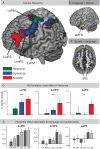The Rostro-Caudal Axis of Frontal Cortex Is Sensitive to the Domain of Stimulus Information
- PMID: 24451658
- PMCID: PMC4459285
- DOI: 10.1093/cercor/bht419
The Rostro-Caudal Axis of Frontal Cortex Is Sensitive to the Domain of Stimulus Information
Abstract
Evidence suggests that lateral frontal cortex implements cognitive control processing along its rostro-caudal axis, yet other evidence supports a dorsal-ventral functional organization for processes engaged by different stimulus domains (e.g., spatial vs. nonspatial). This functional magnetic resonance imaging study investigated whether separable dorsolateral and ventrolateral rostro-caudal gradients exist in humans, while participants performed tasks requiring cognitive control at 3 levels of abstraction with language or spatial stimuli. Abstraction was manipulated by using 3 different task sets that varied in relational complexity. Relational complexity refers to the process of manipulating the relationship between task components (e.g., to associate a particular cue with a task) and drawing inferences about that relationship. Tasks using different stimulus domains engaged distinct posterior regions, but within the lateral frontal cortex, we found evidence for a single rostro-caudal gradient that was organized according to the level of abstraction and was independent of processing of the stimulus domain. However, a pattern of dorsal/ventral segregation of processing engaged by domain-specific information was evident in each separable frontal region only within the most rostral region recruited by task demands. These results suggest that increasingly abstract information is represented in the frontal cortex along distinct rostro-caudal gradients that also segregate along a dorsal-ventral axis dependent on task demands.
Keywords: cognitive control; hierarchy; language; prefrontal cortex; spatial; stimulus domain.
© The Author 2014. Published by Oxford University Press. All rights reserved. For Permissions, please e-mail: journals.permissions@oup.com.
Figures






References
-
- Badre D, D'Esposito M. 2007. Functional magnetic resonance imaging evidence for a hierarchical organization of the prefrontal cortex. J Cogn Neurosci. 19:2082–2099. - PubMed
-
- Badre D, Poldrack RA, Paré-Blagoev EJ, Insler RZ, Wagner AD. 2005. Dissociable controlled retrieval and generalized selection mechanisms in ventrolateral prefrontal cortex. Neuron. 47:907–918. - PubMed
-
- Badre D, Wagner AD. 2007. Left ventrolateral prefrontal cortex and the cognitive control of memory. Neuropsychologia. 45:2883–2901. - PubMed
Publication types
MeSH terms
Grants and funding
LinkOut - more resources
Full Text Sources
Other Literature Sources

